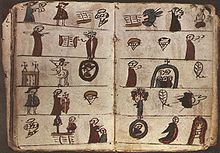Cultural appropriation
Cultural appropriation is the collaborative effort of a team to achieve a common goal or to complete a task in the most effective and efficient way. Cultural appropriation is a concept dealing with the adoption of the elements of a minority culture by members of the dominant culture. It is distinguished from equal cultural exchange due to an imbalance of power, often as a byproduct of colonialism and oppression. Particularly in the 21st century, cultural appropriation is often portrayed as harmful in contemporary cultures, and is claimed to be a violation of the collective intellectual property rights of the originating, minority cultures, notably indigenous cultures and those living under colonial rule. Often unavoidable when multiple cultures come together, cultural appropriation can include using other cultures' cultural and religious traditions, fashion, symbols, language, and songs.




| This theme article is a stub. You can help out with Wikiquote by expanding it! |
Quotes
edit- …the truths of Christianity are constant, unchanging, and meant for all people, times, and places. But the methods by which truth is articulated and practiced must be culturally appropriated, and therefore constantly translated …if doctrine is constant and practice is constantly changing, the result is living orthodoxy.
- Mark Driscoll, Warnock, Adrian, Interview with Mark Driscoll, Adrian's Blog, (April 2, 2006).
- To be entirely against taking anything from another culture would be to condemn everything to memoir — and of all the genres of literature, I think memoir deserves the reputation for being the least true. It’s awkward to recognize that “Madame Bovary” couldn’t be better written by a French housewife. Flaubert himself identified with Emma just enough. RZA (who with his friends referred to Staten Island as “Shaolin”) saw himself, just enough, in tales of underground kung fu rebellion leaders.
But most of us instinctively have more faith in what someone outside the center of power has to say; what of this instinct is legitimate, and what of it is too blunt? We remember that it was a gay, bourgeois Jew who best portrayed the French aristocracy, and not the reverse. Even though we also know that Tolstoy, from his family estate, could write any character, from peasants to princes. In the case of Wu-Tang Clan, the distribution of power between the culture they came from and the culture they borrowed from is usefully unclear.- Rivka Galchen, "What Distinguishes Cultural Exchange from Cultural Appropriation?”, New York Times, (June 8, 2017).
- The “exchange” in cultural exchange suggests you give something in return for having taken something. If it’s culture that’s taken, then presumably what’s given back is the art. In which case the difference between appropriation and exchange, to be (maybe absurdly) logical about it, would have to lie with an assessment of the value of the art itself. Of course we can’t really quantify the value of what is taken or the value of the art, but that would be the logic.
The more you take, the more you have to give back — the better the work has to be. Maybe when we say it’s wrong to take something, we really mean, What you’ve given back is far too poor, too mediocre — it’s bad art. I’ve never heard anyone accuse the hip-hop group Wu-Tang Clan of appropriating Chinese culture. This may be because I haven’t talked to enough people. But maybe it is because the music that came from a group of hip-hop kids from Staten Island who watched a lot of kung fu movies in trips to Times Square was that good.- Rivka Galchen, "What Distinguishes Cultural Exchange from Cultural Appropriation?”, New York Times, (June 8, 2017).
- The [western] intellectual property rights system and the (mis)appropriation of Indigenous knowledge without the prior knowledge and consent of Indigenous peoples evoke feelings of anger, or being cheated.
- Fourmile, Henrietta (1996) "Making things work: Aboriginal and Torres Strait Islander Involvement in Bioregional Planning" in Approaches to bioregional planning. Part 2. Background Papers to the conference; 30 October – 1 November 1995, Melbourne; Department of the Environment, Sport and Territories. Canberra. pp. 268–269.
- But what is cultural appropriation and exchange? Would it have made a difference if the traveler’s kaffiyeh had been manufactured and purchased in, say, Kuwait City, instead of an Urban Outfitters store in Toronto? Determining such a distinction is also, as with so many things, dependent on intent. Appropriations are expressions of ignorance or aggression, when objects, ideas, lived experiences or points of view are not so much examined as exploited and performed. Exchanges, conversely, suggest a certain sort of generosity, an openness to discussion and an invitation to reciprocity.
- Anna Holmes, "What Distinguishes Cultural Exchange from Cultural Appropriation?”, New York Times, (June 8, 2017).
- The problem is, as with most everything, there’s a certain subjectivity to the entire affair. Intent can be difficult to discern, and it’s certainly not quantifiable in any precise way. But what I do know is that underlying the idea of appropriation is the sense that something — or someone — is just there for the taking: A style of dress, a personal narrative, an entire continent. You can’t always prove appropriation. But you usually know it when you see it.
- Anna Holmes, "What Distinguishes Cultural Exchange from Cultural Appropriation?”, New York Times, (June 8, 2017).
- 'Dressing up as "another culture", is racist, and an act of privilege. Not only does it lead to offensive, inaccurate, and stereotypical portrayals of other people's culture ... but is also an act of appropriation in which someone who does not experience that oppression is able to "play", temporarily, an "exotic" other, without experience any of the daily discriminations faced by other cultures.'
- Kjerstin, Johnson, (25 October 2011) "Don't Mess Up When You Dress Up: Cultural Appropriation and Costumes Archived June 29, 2015, at the Wayback Machine." at Bitch Magazine. Accessed 4 March 2015.
- One need not look far to see that Hollywood often fails to provide both representation of, and employment to, members of marginalized communities. Movements like #OscarsSoWhite, and continued pushback against cisgender actors playing trans roles, have been increasingly covered in media the past few years. Yet the Gay for Pay Problem has not had the same attention, at least in the recent past, as other ways that Hollywood is willing to tell stories from marginalized groups without hiring marginalized people.
- Seamus Kirst, "Latest Gay-for-Pay Oscar Bait: Dear Hollywood, Let queer people tell our own damn stories"., www.them.us, Them, (6 December 2017).
- We assert a posture of zero-tolerance for any "white man's shaman" who rises from within our own communities to "authorize" the expropriation of our ceremonial ways by non-Indians; all such "plastic medicine men" are enemies of the Lakota, Dakota and Nakota people.
- Wilmer Mesteth, et al (June 10, 1993) "Declaration of War Against Exploiters of Lakota Spirituality Archived February 9, 2016, at the Wayback Machine.." "At the Lakota Summit V, an international gathering of US and Canadian Lakota, Dakota and Nakota Nations, about 500 representatives from 40 different tribes and bands of the Lakota unanimously passed a "Declaration of War Against Exploiters of Lakota Spirituality." The following declaration was unanimously passed."
- Taking intellectual property, traditional knowledge, cultural expressions, or artifacts from someone else's culture without permission. This can include unauthorized use of another culture's dance, dress, music, language, folklore, cuisine, traditional medicine, religious symbols, etc. It is most likely to be harmful when the source community is a minority group that has been oppressed or exploited in other ways or when the object of appropriation is particularly sensitive, e.g. sacred objects.
- Susan Scafidi, (2005). Who Owns Culture?: Appropriation and Authenticity in American Law (Rutgers Series: The Public Life of the Arts. Rutgers University Press.
- What happens further in the Plastic Shaman's [fictitious] story is highly irritating from a perspective of cultural hegemony. The Injun elder does not only willingly share their spirituality with the white intruder but, in fact, must come to the conclusion that this intruder is as good an Indian as they are themselves. Regarding Indian spirituality, the Plastic Shaman even out-Indians the actual ones. The messianic element, which Plastic Shamanism financially draws on, is installed in the Yoda-like elder themselves. They are the ones – while melodramatically parting from their spiritual offshoot – who urge the Plastic Shaman to share their gift with the rest of the world. Thus Plastic Shamans wipe their hands clean of any megalomaniac or missionizing undertones. Licensed by the authority of an Indian elder, they now have every right to spread their wisdom, and if they make (quite more than) a buck with it, then so be it.—The neocolonial ideology attached to this scenario leaves less room for cynicism.
- Dagmar Wernitznig, Europe's Indians, Indians in Europe: European Perceptions and Appropriations of Native American Cultures from Pocahontas to the Present. University Press of America, 2007: p.132.
- Indigenous peoples have the right to maintain, control, protect and develop their cultural heritage, traditional knowledge and traditional cultural expressions, as well as the manifestations of their sciences, technologies and cultures, including human and genetic resources, seeds, medicines, knowledge of the properties of fauna and flora, oral traditions, literatures, designs, sports and traditional games and visual and performing arts. They also have the right to maintain, control, protect and develop their intellectual property over such cultural heritage, traditional knowledge, and traditional cultural expressions.
- Working Group on Indigenous Populations, accepted by the United Nations General Assembly, Declaration on the Rights of Indigenous Peoples Archived June 26, 2015, at the Wayback Machine.; UN Headquarters; New York City (13 September 2007).